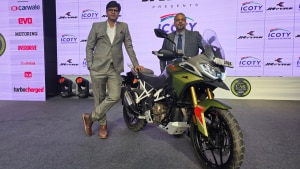Everything you need to know about the 2019 Renault Triber
Renault has unveiled its latest offering for India, the Renault Triber. This is the first of four new cars the company plans on introducing here in the next two years, in a bid to double sales by 2022. The Triber sits on a heavily reworked version of the CMF-A platform. It has been specifically designed for the India market and has been jointly developed by the firm's French and Indian teams.

Positioning
The Renault Triber is unique in its position in the sub-four-metre space. It is meant to be a lifestyle vehicle, aimed at large and nuclear families as well as younger individual buyers with a more active lifestyle. The Triber archieves this mix by having a very flexible interior arrangement and an attractive yet functional exterior design

Interiors
One of the Triber's biggest differentiating points in the crowded sub-four-metre space is the modularity the interior offers. There is space for upto seven adults, given its three-row layout. The second row, however, is sliding, reclinable, foldable and be tumbled, allowing for up to 200mm legroom. The third row meanwhile, comes with two independent removable seats. Renault claims that the 834mm roof height will allow even full-sized passengers to sit here. There are AC vents and power sockets for all passengers.
In the five-seater configuration, the Triber offers 625 litres of boot space, this drops to 320 litres in the six-seater layout and 84 litres in the seven-seater arrangement. There's intuitive cabin storage too, up to 31 litres. The highlight here is the cooled central compartment.
This is accentuated by a cabin that highlights these attributes with its silver-accented dual-tone black and beige colour combination and sharp, geometric elements. Other major features are a new 8-inch touchscreen with Android Auto/Apple Carplay and video playback. The digital instrument cluster also stands out with its three virtual dials. There's keyless entry and push-button starts as well.

Styling
The Triber follows the Renault's latest design language but toned down for the Indian market. So you get the large U-shaped grille with a prominent Renault logo on top. A bit like the Captur but more imposing given this car's smaller footprint. Flanked on either side of this are the tapering rectangular headlamps. These are a bit larger than the Kwid and come with more detailing and projector beams. Finishing this off are the LED DRLs on the bumper, which bisects the wide arrow-shaped intakes.

Accompanying all this is a wide stance, muscular bonnet, roof rails, a large well-proportioned glass-area, optional side-moulding and large wide, beaked tail lamps which accentuate the car's width. More aggressiveness comes from the wide Triber lettering and ornamental skidplates. The front and rear overhangs are quite short in an attempt to maximise interior space. The upright side profile and stepped roof aid practicality, well balanced by the notch at the B-pillar. The optional 15-inch wheels are also well designed, standard wheel size is 14-inch.
As far as numbers go, the Triber is 3990mm long, 1739mm wide and 1643mm tall. The wheelbase is 2636mm and ground clearance is 182mm. Kerb weight is 947 kg.

Engine
Renault has fixed the Triber up with a new 999cc three-cylinder petrol motor which makes 72PS at 6,250 rpm and 96Nm at 3,500 rpm. Renault says this motor already does duty in its international offerings like the Clio and Dacia Sandero in Europe and South America. The biggest difference between this and the motor in the Kwid is that this one gets a dual VVT system which makes for more responsiveness. There are no fuel efficiency figures available yet, but we expect a slight improvement over that of the Kwid 1.0. A BSVI-compliant version will be introduced in due course.
The motor comes paired with a five-speed manual and a five-speed AMT, as in the Kwid.
Safety
Renault claims that the Triber exceeds all India safety regulations. There are three-point seat-belts even for the middle rear passenger and up to four airbags for the driver, passenger and front sides. Expectedly, the Triber will come will safety gear to meet AIS 145 standards, like means a seat belt reminder for driver and co-driver, rear parking sensors and an over-speed alert for the driver.

Pricing and Rivals
The Renault Triber's unique position in the B-segment means that it has few direct rivals. The Datsun Go+ and lower variants of the Maruti Suzuki Ertiga come closest. This unique position also means that Renault India has an opportunity to price the Triber quite aggressively when it launches in the second half of 2019. By our estimates, a starting price of Rs 5.5 lakh ex-showroom is what Renault should be looking at.
Also see: Renault Triber | First Drive
Starts Rs 5.3 Lakhs
999cc
AMT
72
96
20.5 Kmpl
Starts Rs 8.35 Lakhs
1462cc
Automatic
87.55
136.8
20.30 Kmpl














